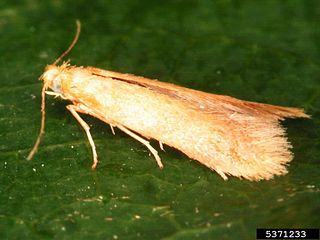Palaephatoidea is a superfamily of insects in the order Lepidoptera with a single family, Palaephatidae with seven known genera. These "Gondwanaland moths" exhibit a disjunct distribution occurring mainly in South America, with four species in eastern Australia and Tasmania and one in South Africa. The larvae spin together leaves of Proteaceae (Ptyssoptera) or Verbenaceae (Azaleodes) . Palaephatoidea, a typical monotrysian group, is one two main candidates as the sister group of most of the Lepidoptera, the Ditrysia.

Tischerioidea is the superfamily of "trumpet" leaf miner moths. The superfamily contains just one family, Tischeriidae, and traditionally one genus, Tischeria, but currently three genera are recognised, widespread around the world including South America, except for Australasia. This is one candidate as the sister group of the bulk of Lepidoptera, the Ditrysia, and they have a monotrysian type of female reproductive system. These small moths are leaf-miners in the caterpillar stage, feeding mainly on Fagaceae, Asteraceae, and Malvaceae (Astrotischeria), and some also on Rhamnaceae, Tiliaceae, and Rosaceae.

The Monotrysia are a group of moths in the lepidopteran order, not currently considered to be a natural group or clade. Apart from the recently discovered family Andesianidae, most of the group consists of small, relatively understudied species. The group is so named because the female has a single genital opening for mating and laying eggs, in contrast to the rest of the Lepidoptera (Ditrysia), which have two female reproductive openings. They comprise all of the group Heteroneura apart from the Ditrysia.
Palaephatus albicerus is a moth of the family Palaephatidae. It was described by Davis in 1986. It is found in Chile, from the southern limits of the Coquimbo Desert in the Choapa Province, south through the coastal ranges to Valdivia and Petrohue.
Palaephatus falsus is a moth of the family Palaephatidae. It was described by Arthur Gardiner Butler in 1883. It is found in the Valdivian forest region of southern Chile from the Nahuelbuta Mountains south to Chiloé Island. In southern Argentina it is found from the adjacent Andean forests of the Neuquén Province south to the Interoceanic Magellanic region of southern Tierra del Fuego.
Palaephatus luteolus is a moth of the family Palaephatidae. It was described by Donald R. Davis in 1986. It is found in the Valdivian forest region of southern Chile and Argentina, from the Cautin Province and the Neuquen Province south to the Interoceanic Magellanic region of Tierra del Fuego.
Palaephatus pallidus is a moth of the family Palaephatidae. It was described by Donald R. Davis in 1986. It is found in the southern temperature forest of Chile and the adjacent Andean frontier of Argentina.
Palaephatus albiterminus is a moth of the family Palaephatidae. It was described by Donald R. Davis in 1986. It is found in the wetter areas of the temperate, Valdivian forests of southern Argentina and Chile.
Palaephatus dimorphus is a moth of the family Palaephatidae. It is found in much of the southern temperate forests of montane Argentina and Chile.
Palaephatus fusciterminus is a moth of the family Palaephatidae. It is found in the Valdivian forests of southern Argentina and Chile.
Palaephatus latus is a moth of the family Palaephatidae. It is found in the Arauco Province of Chile.
Palaephatus leucacrotus is a moth of the family Palaephatidae. It is found in the wetter areas of the Valdivian forest region of south-central Chile.
Palaephatus nielseni is a moth of the family Palaephatidae. It is found in the wetter areas of the Valdivian forest region of southern Argentina and Chile.
Palaephatus spinosus is a moth of the family Palaephatidae. It is found in forests in the Osorno Province of southern Chile.
Palaephatus striatus is a moth of the family Palaephatidae. It is found in the wetter Valdivian forests of central Argentina and Chile from Lago Puyehue and Lago Nahuel Huapi south to Chiloe Island.
Sesommata paraplatysaris is a moth of the family Palaephatidae. It was described by Davis in 1986. It is found in the montane, temperate forests of southern Argentina and Chile.
Sesommata albimaculata is a moth of the family Palaephatidae. It was described by Davis in 1986. It is found in the Parque Nacional Lanín in Argentina.
Sesommata platysaris is a moth of the family Palaephatidae. It was described by Edward Meyrick in 1931. It is found in the lake region in Argentina, including Lácar Lake and especially Nahuel Huapi Lake.
Metaphatus is a genus of moths in the family Palaephatidae. It was described by Donald R. Davis in 1986.
Metaphatus ichnius is a moth of the family Palaephatidae. It was described by Donald R. Davis in 1986. It is found in the temperate Andean forests of southern Chile, from Malleco Province south to Chiloe Island.

